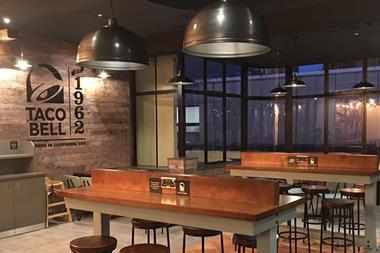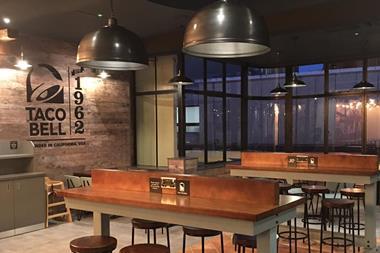Taco Bell may be a well-known brand by name, but it’s only been in the past five years that it has made its mark on the streets of Britain. Georgi Gyton meets with general manager for Europe, Jorge Torres to discuss why the brand has an advantage over other operators and how social media is enabling is to tap into its target fan base.
When Taco Bell first arrived in the UK, in the mid-80s, it was a very different time. Findus’ Crispy Pancakes and Angel Delight were common place TV dinners, and there was little understanding or awareness about Mexican food. That coupled with a flawed development strategy means that by the mid-90s the three centrally located and “very expensive” London sites it had are no longer.
“It didn’t work. It was a different nation and a different brand back then and it didn’t click,” explains Jorge Torres, general manager, Taco Bell Europe. “We had great locations in Leicester Square and Earls Court, but they were very expensive areas and the brand was barely known. Mexican food was also not known well in Europe, which is not the case now – it’s everywhere,” he says.
Fast-forward another 10 years or and the brand decided to try again, with a renewed interest in expanding Taco Bell globally. Spain was added as a territory, alongside the UK in 2010, and Taco Bell now has a presence in several other European countries, including: Finland, the Netherlands, Iceland, Romania and Cyrus, and it is working to expand this list.
In addition to UK consumers now being “obsessed with food”, and particularly anything exotic and inventive, Torres says the strategy is very different, and is paying off, with the past five years seeing the brand really take off in the UK. “This time it’s different. We are looking at locations in terms of customer demographics and the economics. And for 10 years we didn’t look to move into central London, until we had the business somewhat established outside the capital,” he explains. Taco Bell opened its first site in London last November, in Hammersmith, and now has four sites in Greater London.
Torres was brought in at the beginning of 2018 with the purpose of building a team that would transform the growth of Taco Bell in the UK and mainland Europe. “We see the UK as one of the countries with the highest potential for growth, therefore we spend a lot of our time on this market,” he said. The head office team has now expanded from four people to c15, with more on the way, and it recently relocated to the same head office building as sister-company KFC in Woking, in the last quarter of 2018. “We have a very strong team right now. We have secured all the key functions and established a platform that will enable us to grow over the next few years,” believes Torres.
“It is reflective of what is going on with Taco Bell right now, the growth of the brand in Europe and the interest of Yum! in the brand as a growth engine for the company,” says Torres. The operator has 50 sites in Spain and, at the time of going to press, is just about to open its 40th UK site in Chatham Dockside in Kent, with a site in Wimbledon not far behind.
Taco Bell is looking to open a further 20 restaurants in the UK during the course of 2019, as it aims to reach the heights of c170 sites over the next five years. As part of this it is also looking to double the size of its estate in London this year – and sees up to 50 of those 170 target stores being in the capital. “London is a country on its own, and we are just scratching the surface,” he explains. “We are hoping to develop in London even further and are looking at areas like Clapham.”
However, Torres says London is by no means the only focus, and that it is looking at all geographical locations in the UK, particularly those where it has no presence at the moment, such as Birmingham. In addition to new geographies, the operator has already started doubling up in some cities, opening its second in Glasgow in April, and it’s second in Doncaster – a drive thru site in Herten Triangle – earlier this month.
In the very long-term Torres says he can see Taco Bell reaching an estate of up to 600, but admits that this will take years, and will depend very much on the franchise partners it secures and the site opportunities that present themselves. “The faster you reach that scale, the better the business operates in terms of efficiencies – it’s a virtuous circle,” he says.
In the UK it has a combination of franchisees – in the smaller territories in Europe where it only has five or six sites, it currently only has a sole franchise partner – with its three main partners also KFC franchisees. They operate loosely within three territories – the north, south and Scotland. “We are not covering the full geography of the UK – there are many spots that offer great opportunities, so we are constantly looking for partners that can help us develop the UK market,” he explains.
While the launch in central London created a halo-effect in terms of PR, prompting interest from a number of potential partners, finding the right partner that will have the operational capability, the understanding and love of the brand, and that shares the same kind of culture and spirit that it has at Yum! is not always easy, says Torres.
The flexibility of its formats is one of Taco Bell’s strengths in terms of the ability to expand and to open the right sites in the right places, says Torres. “We can go into 400 sq. ft locations in shopping centres, up 3,000 sq. ft sites and drive-thrus. And in between we have a combination of in-line formats as well,” he says. The brand is currently experiencing good momentum with its smaller 1,200-1,600 sq. ft in-line format, which is proving very effective in terms of sales per sq. ft, adds Torres.
Taco Bell is also keen to boost the drive-thru side of the business, though Torres doesn’t believe they will ever take off in the same way they have in the US where they are more reliant on cars. “In the US, 70% of Taco Bell’s sales come through the drive-thrus. It is a behaviour that is so embedded in the industry over there,” he says, but he is keen to build them into its operating model, in order to create a balanced portfolio. “I think that drive-thru sales will slowly grow to be a considerable part of our business – I would like to see it at c30%,” he adds.
The social brand
But it’s not just evolving consumer tastes and a well more thought-out property strategy that is helping Taco Bell to make its mark on UK soil this time round, it’s the brand’s connection to its target audience.
The brand was different when it first entered the UK – more traditional, says Torres. But now it’s a different story. “I have never seen a brand that has connected so well with popular culture and youth,” he explains. Its use of social media channels, PR and marketing, and partnerships has enabled it to tap into its target audience in a language they can relate to.
From its link-up with fashion retailer Forever 21 – which resulted in a Taco Bell branded clothing line, the wedding chapel it has in its Las Vegas branch, to its partnership with Dorito’s on its Crunch Burrito, Taco Bell isn’t afraid to do something a little bit different. Brand loyalty is so strong that devote customers have even had the Taco Bell logo tattooed on them, says Torres.
“Our brand voice is very different to other fast food operators,” he says. “We sell alcohol in our restaurants and we don’t have a ‘happy meal’ by principle,” he says. While its actual customer demographic is wide ranging, for Taco Bell it’s all about the millennial generation when it comes to targeting their brand – 18 to 35-year-olds who are looking for something a bit different, who are tired of the same pizza, burger or fried chicken options, and want something unique, he explains. A generation that are most likely to become brand ambassadors.
Even the stores don’t have the traditional cues of fast food, which often feature red and yellow colouring in their branding. “Here there is a lot of purple, neon, murals from local artists on the walls, moveable chairs, charging points for phones and wifi. We also have an open kitchen, so you can see your food being prepared.” For Torres, the restaurant should be an experience for the customers and where the brand really comes to life.
While Taco Bell is still a young brand in terms of its presence in the UK, the business has found that customers have a lot of pre-awareness about Taco Bell due to its heritage in the US, explains Torres, which he feels put the operator at an advantage over other new brands entering the market.
“London was the most requested city in the world that people requested a Taco Bell opened in on social media,” he says. “People were even upset that we weren’t there – what kind of brand are you if you are not in London? That was great insight for us to know that was the right place to be,” he says.
Category of one
Taco Bell likes to call itself a ‘category of one’ when it comes its food offering. “We are not like Tortilla or Chipotle, for example. We take inspiration from Mexican forms and flavours and bring them to the customer in a way that is unique and modern. “We like to do things a bit differently, like creating nachos out of fried chicken, rather than tortilla – that kind of innovation gives Taco Bell the edge.
Its Crunchwrap Supreme is one of the most popular items of its everyday menu – featuring a choice of protein, lettuce, tomatoes, sour cream, tostada shell and nacho cheese sauce in a grilled flour tortilla; while its original innovation, the Crunch Taco has been around so long and is so popular it even has its own emoji.
Taco Bell introduces new products six times a year, for example it introduced box meals at the beginning of the year, and sometimes bring back big sellers from previous years if enough people request them. “We have an arsenal of products coming from the US,” he says. “Since its beginnings in the ‘60s there have been hundreds of products that we can commercialise and bring to Europe – and people in the restaurants are asking for them. You’d be surprised how aware customers in the UK are of products sold in Taco Bells in the US,” he explains.
Something available in the US but not the UK currently, are breakfast items, and it’s something that Torres is keen to bring to the UK soon. “We think there is an opportunity and the way that they do it in the US is amazing,” he said. Its range there includes grilled breakfast burritos with egg, nacho cheese sauce and sausage crumbles, mini skillet bowls, and sausage flatbread quesadillas.
The night time day-part is also “a big opportunity for us”, he added. Its typical trading hours are currently lunchtime and evenings, but it does have promotions such as Taco Tuesdays in order to drive customer spend in the afternoon, said Torres.
While the majority of its stores close between 8-10pm, some are open much later, such as its restaurant in Glasgow’s Sauchiehall Street, which is open till 4am. “It is an interesting neighbourhood where customers either work, live or play,” said Torres.
In terms of the evening opportunity, he said it makes a lot of sense in terms of the characteristics of the brand and the target audience it wants to reach. However, while Taco Bell sells alcohol – beers and hard shakes – at its restaurants, Torres said that this is a bonus in terms of sales and that people come for the food.
In addition to innovation, and increasing awareness of the brand, delivery is another area that is growing sales for Taco Bell. It depends on the site, with some taking c15% of their sales from delivery and others closer to 40%, but overall orders are “piling up” day by day, says Torres. “Delivery is happening, so it’s all about thinking about how you approach it in a way that can really represent the brand, and in a unique way,” he says. “We are constantly working with our partners on how to bring the Taco Bell experience to the customer through delivery – not just from a food quality perspective, but from a brand experience.”
The work the company has done to create a buzz around the brand, including PR stunts and social media marketing, and its arrival in London, is translating into positive sales growth, and Torres says he is very optimistic about its top line. Sales were up 11% year-on-year in Q1, with transactions up 8% in the first quarter. “We feel confident about trading, and we are looking at opportunities for sites and to develop the brand further,” he says. “For us the challenge is scale. How can we achieve it faster?”
With 40 sites Taco Bell is still a small fish when it comes to the likes of its sister brands, but with the support and expertise of Yum! Brands, and the experience gleaned from the operation of more than 7,000 restaurants in the US, Torres believes it is well positioned for growth.
Precis
Second coming
While Taco Bell may be a major player on the global stage, it has only been in the past five years that it has made its mark on the streets of Britain, after an ultimately doomed entry to the UK market in the 80s. Georgi Gyton meets with general manager for Europe, Jorge Torres, to discuss why the brand has an advantage over other operators and how social media is enabling it to tap into its target fan base.










































